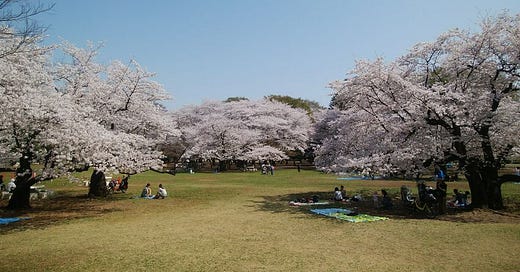#31 Disaster parks, PH-Lamps and Bruno Munari
It’s Design Lobster #31. Welcome to all the new readers who joined last week. For the Bank Holiday I give you life-saving parks and flattering lamps. A mellow start to the week. 🌳🕯
✨Enjoying Design Lobster? Please share it with a friend, colleague or fellow designer.
Question: How might a park save your life?
Long-term readers will now how much I love design in disguise. In Design Lobster #8 we admired an 18th century snuff box disguised as a shoe and in Design Lobster #23 we were flummoxed by a cleverly disguised lock. Recently I was fascinated to learn about the network of parks in Tokyo that in normal times provide recreation, but in times of crisis act as crucial national infrastructure for disaster relief. As well as simply providing open space to break fires and host survival camps, the parks conceal bunkers of equipment and non-perishable food.


Some of the smaller touches are extremely inventive. Lamp posts are fitted with solar panels and electrical outlets, manhole covers can be removed to reveal emergency toilets. My favourite, as shown above, is the way that many of the park benches can be reassembled into cooking stoves.
This kind of thinking has become second nature in Tokyo, situated as it is in a region that suffers regularly from terrible earthquakes. As other societies around the world seek improved resilience to shocks such as covid-19, I think there’s much to learn from these multifunctional benches.
Design takeaway: How could your design be adapted for use in a crisis?
🫨 Listen to a podcast about Japan’s preparations for the next big earthquake.
Object: PH-Lamp
Poul Henningsen was a self-taught Danish architect and designer, who among many other things invented a self-inflating bicycle. He is most famous for his Artichoke lamp and PH-lamp – the latter first exhibited in 1925. Both of these projects were preoccupied with how to moderate then-new electric light so that it gave less glare and more warmth. Apocryphally, it was his mother’s complaint that she looked too wrinkled in harsh electric light that was the designer’s starting provocation.
Henningsen designed more than 100 variations of the PH-lamp, but they all use the same principle of multiple overlapping translucent shades to break and colour the light. The soft light they produce and high quality workmanship nowadays have made them very expensive collector’s items.
I must confess that I’m a stickler for getting the right ambience with lighting. I have been known to spend the first half hour in an AirBnB rearranging the lamps until I am satisfied. I see in Poul a kindred spirit 😬.
More importantly, I think this project also shows why designers continually revisit the lamp. Designing a lamp well is not just a question of how it looks or how much light it throws, but what the quality of that light is, and the atmosphere it creates. These are slippery questions that require careful judgement of technology, people and situations, questions that designers are best placed to answer.
Design takeaway: Does your design create an atmosphere?
💡 Watch Poul Henningsen describe his Philosophy of Light here.
Quote: “…anyone who uses a properly designed object feels the presence of an artist who has worked for him, bettering his living conditions and encouraging him to develop his taste and sense of beauty.”
– Bruno Munari, author of Design as Art
I love the first half of this quote because it describes what designers do in very beautiful terms. In Bruno’s mind the designer remains present in their work long after the act of design is over. It is as if we are giving part of ourselves to every design. Some readers however, might not agree with his rather paternalistic view in the second part of the quote. In any case, I can thoroughly recommend his book.
Keep discovering. 🦞
Has this email been forwarded? Sign up below to get the weekly emails delivered to you. ✏️





